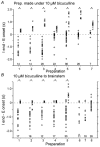GABAA and glycine receptors in regulation of intercostal and abdominal expiratory activity in vitro in neonatal rat
- PMID: 12909685
- PMCID: PMC2343214
- DOI: 10.1113/jphysiol.2003.042689
GABAA and glycine receptors in regulation of intercostal and abdominal expiratory activity in vitro in neonatal rat
Abstract
The roles played by GABAA and glycine receptors in inspiratory-expiratory motor co-ordination and in tonic inhibitory regulation of expiratory motor activity were studied using brainstem-spinal cord (-rib) preparations from neonatal rats. Inspiratory activity was recorded from the C4 ventral root. Expiratory activity in internal intercostal muscle, internal oblique muscle or T13 ventral root was evoked by a decrease in perfusate pH from 7.4 to 7.1 (i.e. from normal to low pH conditions) and was limited to the first part of the expiratory phase. Under low pH conditions, bath application of 10 microM bicuculline, a GABAA receptor antagonist, caused the inspiratory burst to overlap the expiratory burst in 2/7 preparations. Overlapping of the expiratory burst with the inspiratory burst was observed in 7/7 preparations made under 10 microM bicuculline. Furthermore, such preparations exhibited expiratory bursts under bicuculline-containing normal pH conditions. Local application of 10 microM bicuculline to the brainstem under normal pH conditions evoked expiratory bursts, some of which overlapped the inspiratory bursts. Picrotoxin, another antagonist of the GABAA receptor, had similar effects. Under normal pH conditions, application of strychnine (0.2- 2.0 microM; a glycine receptor antagonist) to the brainstem did not evoke expiratory bursts. On subsequent application of strychnine-containing low pH solution, expiratory bursts were evoked and some (0.5 microM) or all (2.0 microM) of these overlapped the inspiratory burst. Simultaneous application of picrotoxin and strychnine to the brainstem evoked expiratory bursts that overlapped the inspiratory bursts and a subsequent decrease in perfusate pH to 7.1 increased the frequency of the respiratory rhythm. It was a characteristic finding that the duration of the expiratory burst exceeded that of the inspiratory burst under control low pH conditions. This remained true during concurrent blockade of GABAA and glycine receptors. The results suggest that in the in vitro preparation from neonatal rats: (1) GABAA and glycine receptors within the brainstem play important roles in the co-ordination between inspiratory and expiratory motor activity, (2) tonic inhibition via GABAA receptors, but not glycine receptors, plays a role in the regulation of expiratory motor activity and (3) inspiratory and expiratory burst termination is independent of both GABAA and glycine receptors.
Figures










Similar articles
-
Intercostal expiratory activity in an in vitro brainstem-spinal cord-rib preparation from the neonatal rat.J Physiol. 1999 Oct 1;520 Pt 1(Pt 1):293-302. doi: 10.1111/j.1469-7793.1999.00293.x. J Physiol. 1999. PMID: 10517820 Free PMC article.
-
Role of synaptic inhibition in turtle respiratory rhythm generation.J Physiol. 2002 Oct 1;544(Pt 1):253-65. doi: 10.1113/jphysiol.2002.019687. J Physiol. 2002. PMID: 12356896 Free PMC article.
-
Rostrocaudal distribution of spinal respiratory motor activity in an in vitro neonatal rat preparation.Neurosci Res. 2004 Nov;50(3):263-9. doi: 10.1016/j.neures.2004.07.011. Neurosci Res. 2004. PMID: 15488289
-
Respiratory network function in the isolated brainstem-spinal cord of newborn rats.Prog Neurobiol. 1999 Dec;59(6):583-634. doi: 10.1016/s0301-0082(99)00009-x. Prog Neurobiol. 1999. PMID: 10845755 Review.
-
Abdominal respiratory motor pattern in the rat.Adv Exp Med Biol. 2010;669:157-61. doi: 10.1007/978-1-4419-5692-7_31. Adv Exp Med Biol. 2010. PMID: 20217340 Review.
Cited by
-
Atoh1-dependent rhombic lip neurons are required for temporal delay between independent respiratory oscillators in embryonic mice.Elife. 2014 May 14;3:e02265. doi: 10.7554/eLife.02265. Elife. 2014. PMID: 24842997 Free PMC article.
-
Abdominal expiratory activity in the rat brainstem-spinal cord in situ: patterns, origins and implications for respiratory rhythm generation.J Physiol. 2009 Jul 15;587(Pt 14):3539-59. doi: 10.1113/jphysiol.2008.167502. Epub 2009 Jun 2. J Physiol. 2009. PMID: 19491247 Free PMC article.
-
Abdominal expiratory muscle activity in anesthetized vagotomized neonatal rats.J Physiol Sci. 2009 May;59(3):157-63. doi: 10.1007/s12576-009-0020-3. Epub 2009 Feb 6. J Physiol Sci. 2009. PMID: 19340545 Free PMC article.
-
Glycine and GABAA receptors suppressively regulate the inspiratory-related calcium rise in the thoracic inspiratory cells of the neonatal rat.J Physiol Sci. 2022 Oct 3;72(1):24. doi: 10.1186/s12576-022-00850-4. J Physiol Sci. 2022. PMID: 36192688 Free PMC article.
-
Isolated in vitro brainstem-spinal cord preparations remain important tools in respiratory neurobiology.Respir Physiol Neurobiol. 2012 Jan 15;180(1):1-7. doi: 10.1016/j.resp.2011.10.002. Epub 2011 Oct 12. Respir Physiol Neurobiol. 2012. PMID: 22015642 Free PMC article. Review.
References
-
- Arata A, Onimaru H, Homma I. Possible synaptic connections of expiratory neurons in the medulla of newborn rat in vitro. Neuroreport. 1998;9:743–746. - PubMed
-
- Bajic J, Zuperku EJ, Tonkovic-Capin M, Hopp FA. Expiratory bulbospinal neurons of dog. I. Control of discharge patterns by pulmonary stretch receptors. Am J Physiol. 1992;262:R1075–1086. - PubMed
-
- Brockhaus J, Ballanyi K. Synaptic inhibition in the isolated respiratory network of neonatal rats. Eur J Neurosci. 1998;10:3823–3839. - PubMed
-
- Büsselberg D, Bischoff AM, Paton JFR, Richter DW. Reorganisation of respiratory network activity after loss of glycinergic inhibition. Pfugers Arch. 2001;441:444–449. - PubMed
-
- Dogas Z, Krolo M, Stuth EA, Tonkovic-Capin M, Hopp FA, McCrimmon DR, Zuperku EJ. Differential effects of GABAA receptor antagonists in the control of respiratory neuronal discharge patterns. J Neurophysiol. 1998;80:2368–2377. - PubMed
MeSH terms
Substances
LinkOut - more resources
Full Text Sources
Miscellaneous

